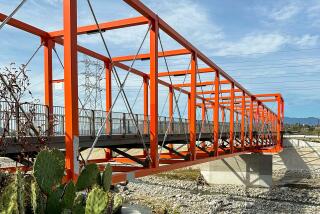TRAVELING IN STYLE : Side Trips : ROMANCING THE SPAN
- Share via
Everybody loves bridges. The luminous towers of the Golden Gate emerging from the fog, the ancient water- and wind-worn stone of an unnamed footbridge over a small canal in Venice, the mysterious covered bridges of New England--these are signal images, powerful, evocative, exciting.
Japan is a country that could scarcely exist without bridges. A nation of islands, rivers and canals, it is quite literally bound together by them. Kurashiki, a booming city on Japan’s Inland Sea, has since 1988 also been the terminus of one of the country’s most impressive bridges, the 7 1/2-mile-long Seto Ohashi, said to be the longest double-deck car-and-train bridge in the world. What better place than Kurashiki, then, for a museum dedicated to the beauty, power and social and economic importance of bridges?
Designed by architect Atsushi Ueda, the Museum of Bridge, as the sign outside reads in English, opened about the same time that the Seto Ohashi was completed. Railed steps lead up from each corner of the building, covering and diverging across the stepped roof, giving visitors the thrill of clambering over a giant bridge. From the top you can glimpse the Inland Sea and the elegant tracery of the Seto Ohashi. Down below, off to one side, is a children’s play park with 11 wood and stone bridges of its own. In the entry plaza, a playful monument to the first iron bridge and the first steam locomotive, both built in England, dances in time to mechanical music.
Through the glass sides of the main hall, you can see the museum’s largest exhibit: a half-scale model of an unbuilt bridge that the great Italian architect Andrea Palladio designed to span the Grand Canal in Venice. Most of the museum’s exhibits are upstairs--models of bridges built by anonymous artisans and famous engineers alike. Here are rope bridges that would test the nerve of an Indiana Jones and wooden structures cleverly designed to collapse in the face of a flood and to be reassembled when the waters subside. A model ship circles beneath a selection of the world’s most ingenious swing bridges and drawbridges, from the Thames to the Bosporus.
Spanning the ravines and lakes within a fantastic rocky landscape are tiny models of the “Hundred Dream Bridges” drawn by the late-18th/early-19th-Century artist Hokusai. Nearby are 65 designs for “The Bridge of the Future,” commissioned by the museum. Most are technological marvels--but first prize was awarded to an entry from Russia, in which a wizened peasant looks down on a high-rise city from a bridge which itself contains a river, a fragment of nature imposed on the man-made, rather than the other way around.
More to Read
Sign up for The Wild
We’ll help you find the best places to hike, bike and run, as well as the perfect silent spots for meditation and yoga.
You may occasionally receive promotional content from the Los Angeles Times.






